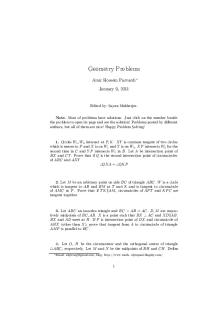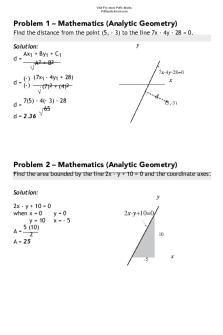445-2 Differential Geometry Homework 1 solutions PDF

| Title | 445-2 Differential Geometry Homework 1 solutions |
|---|---|
| Course | Differential Geometry |
| Institution | Northwestern University |
| Pages | 3 |
| File Size | 70.9 KB |
| File Type | |
| Total Downloads | 11 |
| Total Views | 140 |
Summary
Download 445-2 Differential Geometry Homework 1 solutions PDF
Description
445-2 Differential Geometry Northwestern University Solution of Homework 1 1) Let p, q be two positive integers and consider the C-action on (Cp \{0})× (C \{0}) given by q
t · (z1 , . . . , zp , w1 . . . , wq ) = (et z1 , . . . , et zp , eitw1 , . . . , eit wq ), where t ∈ C, and (z1 , . . . , zp ) ∈ Cp \{0}, (w1 , . . . , wq ) ∈ Cq \{0}. (a) Show that this action is free. Call then Xp,q the quotient complex manifold. (b) Show that Xp,q is diffeomorphic to S 2p−1 × S 2q−1 , a product of odddimensional spheres. Solution. (a) Let us use the more compact notation t · (z, w) = (et z, eitw). Then if this equals (z, w) we must have et = 1 so t = 2πik for some k ∈ Z, but also eit = 1 so t = 2πℓ for some ℓ ∈ Z, which implies that t = 0, so the action is free. (b) If we write t = x + iy with x, y ∈ R, then t · (z, w) = (ex eiy z, e−y eix w), and |ex eiy z| = 1 iff x = − log |z| while |e−y eixw| = 1 iff y = log |w|. Therefore with these choices of x, y we see that t · (z, w) lies on the product of the unit spheres S 2p−1 × S 2q−1 . The map we just defined i log |w| z −i log |z| w ∈ S 2p−1 × S 2q−1 , (z, w) 7→ e ,e |w| |z| clearly descends to a smooth and bijective map Xp,q → S 2p−1 × S 2q−1 with smooth inverse induced by the inclusion S 2p−1 × S 2q−1 ⊂ (Cp \{0}) × (Cq \{0}), and therefore it gives a diffeomorphism.
1
2) Let X be a compact complex manifold of complex dimension n and assume that f : CPn → X is a holomorphic map which is also a finite sheeted covering. Prove that X must be biholomorphic to CPn . Then find a compact real manifold Y of dimension 2n and a nontrivial finite sheeted smooth covering map f : CPn → Y for any n odd. Solution. Assume that f : CPn → X is a finite sheeted holomorphic covering map. Then the deck transformations of f act on CPn as biholomorphisms. But we know that Aut(CPn ) = P GL(n + 1, C), i.e. all biholomorphisms of CPn are induced by invertible linear transformations of Cn+1. Any such transformation is represented by a matrix A ∈ GL(n+1, C), which therefore has a nonzero eigenvector v, so Av = λv for some nonzero complex number λ. This means that the induced map on CPn fixes the point that corresponds to v. But a deck transformation of a nontrivial covering space does not have fixed points unless it is the identity, and we are done. The easiest counterexample when Y is not complex is Y = RP2 double covered by S 2 = CP1 . Obviously the reflection on CP1 is not holomorphic since it reverses the orientation. Similarly we construct a “reflection” on CP2n+1 by sending [z0 : · · · : z2n+1] to [z1 : −z0 : z3 : −z2 : · · · : z2n+1 : −z2n ]. This is a smooth map without fixed points, so the quotient is a smooth manifold Y double covered by CP2n+1. There are no counterexamples for n even, since any covering space f : CP2n → X is trivial. This is because every continuous map from CP2n to itself has a fixed point (using the Lefschetz fixed point theorem). 3) Let X = C2 /Λ be the complex torus given by the square lattice Λ generated by (1, 0), (i, 0), (0, 1), (0, i) over Z. Consider the holomorphic map σ : C2 → C2 given by 1 σ(z, w) = z + , −w . 2 (a) Show that σ induces a holomorphic involution σ : X → X that has no fixed points. It follows that the quotient Y = X/σ is a compact complex manifold with complex dimension 2. (b) Show that there is no nonzero holomorphic 2-form on Y . (c) Show that there is a never-vanishing smooth (2, 0)-form on Y . 2
Solution. (a) Obviously σ ((z, w) + Λ) ⊂ σ(z, w) + Λ, so we get a holomorphic map σ : X → X. Clearly σ ◦ σ(z, w) = (z + 1, w) which is the same as (z, w) in the torus, so σ is an involution. If we had σ(z, w) ∈ (z, w) + Λ, then z + 12 would differ from z by a Gaussian integer, which is false, so σ has no fixed points. (b) Call π : X → Y the quotient map. If ϕ is a holomorphic 2-form on Y , then π ∗ ϕ is a holomorphic 2-form on X. But on X we have the never-vanishing holomorphic 2-form dz ∧ dw, so the quotient π∗ϕ dz ∧ dw is a global holomorhic function on X, which is therefore constant. So π ∗ ϕ = cdz ∧ dw, and since π ∗ ϕ is the pullback of a form from Y we have σ ∗ π ∗ ϕ = π ∗ ϕ. This implies cdz ∧ dw = cσ ∗ (dz ∧ dw) = −cdz ∧ dw, which shows that c = 0 and π ∗ ϕ = 0. But π is a holomorphic covering, so a local isomorphism, and therefore ϕ = 0. (c) Write z = x + iy, w = s + it with x, y, s, t ∈ R. The never-vanishing smooth (2, 0)-form e2πixdz ∧ dw on X (which is well-defined) is invariant under σ because σ ∗ (e2πixdz ∧ dw) = −e2πix+πi dz ∧ dw = e2πixdz ∧ dw, and so it descends to Y .
3...
Similar Free PDFs

Homework 1 Solutions
- 2 Pages

Homework 1 solutions
- 9 Pages

150 Geometry Problems With Solutions
- 23 Pages

498 HW1 - Homework 1 solutions
- 5 Pages

CSC242 homework 1 6 solutions
- 3 Pages

CS-104 - Homework 1 Solutions
- 3 Pages
Popular Institutions
- Tinajero National High School - Annex
- Politeknik Caltex Riau
- Yokohama City University
- SGT University
- University of Al-Qadisiyah
- Divine Word College of Vigan
- Techniek College Rotterdam
- Universidade de Santiago
- Universiti Teknologi MARA Cawangan Johor Kampus Pasir Gudang
- Poltekkes Kemenkes Yogyakarta
- Baguio City National High School
- Colegio san marcos
- preparatoria uno
- Centro de Bachillerato Tecnológico Industrial y de Servicios No. 107
- Dalian Maritime University
- Quang Trung Secondary School
- Colegio Tecnológico en Informática
- Corporación Regional de Educación Superior
- Grupo CEDVA
- Dar Al Uloom University
- Centro de Estudios Preuniversitarios de la Universidad Nacional de Ingeniería
- 上智大学
- Aakash International School, Nuna Majara
- San Felipe Neri Catholic School
- Kang Chiao International School - New Taipei City
- Misamis Occidental National High School
- Institución Educativa Escuela Normal Juan Ladrilleros
- Kolehiyo ng Pantukan
- Batanes State College
- Instituto Continental
- Sekolah Menengah Kejuruan Kesehatan Kaltara (Tarakan)
- Colegio de La Inmaculada Concepcion - Cebu









